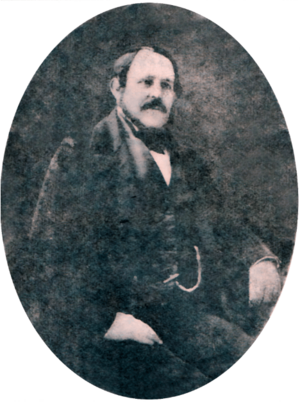José Ballivián facts for kids
Quick facts for kids
José Ballivián
|
|
|---|---|

Portrait by Antonio Villavicencio, Museo de Charcas, Sucre
|
|
| 9th President of Bolivia | |
| In office 27 September 1841 – 23 December 1847 Provisional: 27 September 1841 – 15 August 1844 |
|
| Preceded by | Mariano Enrique Calvo (acting) |
| Succeeded by | Eusebio Guilarte (acting) |
| Minister of War | |
| In office 27 March 1839 – 13 July 1839 |
|
| President | José Miguel de Velasco |
| Preceded by | Otto Philipp Braun |
| Succeeded by | Manuel Eusebio Ruiz |
| Personal details | |
| Born | 5 May 1805 La Paz, Viceroyalty of the Río de la Plata (now Bolivia) |
| Died | 6 October 1852 (aged 47) Rio de Janeiro, Empire of Brazil |
| Resting place | Crypt of the San Francisco Museum, La Paz, Bolivia |
| Spouse | Mercedes Coll |
| Children | 7 (including Adolfo Ballivián) |
| Parents | Jorge Ballivián Isidora Segurola |
| Signature |  |
José Ballivián Segurola (born May 5, 1805 – died October 6, 1852) was an important Bolivian general. He led Bolivia during the Peruvian-Bolivian War of 1841-1842. He also served as the ninth president of Bolivia from 1841 to 1847.
Contents
Early Life and Military Career
José Ballivián was born in La Paz to a wealthy family. His early military career was not very special. He first supported the Spanish king until 1822. Then, at 18, he joined the army fighting for independence.
He slowly moved up in the Bolivian army. He played an important part in the victory over General Salaverry at the Battle of Socabaya in 1836. Ballivián was also a supporter of Santa Cruz, another important leader, in the 1830s.
The Battle of Ingavi: A Turning Point
Ballivián's most famous moment came in November 1841. At 37, he was the chief of the Bolivian Army. He brought together different groups in the army to fight a large invasion from Peru. The Peruvian army was led by their President, Agustín Gamarra.
At the Battle of Ingavi, Ballivián led his troops to a surprising and huge victory. They defeated Gamarra's forces. This battle was a major event in Bolivian military history. It saved Bolivia's independence. Ballivián became a national hero overnight. The Bolivian Congress quickly made him the Provisional President.
José Ballivián as President
José Ballivián was elected president in 1842. He was a skilled leader who made important changes. He updated the country's Constitution. He also worked to keep his supporters happy, much like Santa Cruz had done.
During his time as president, Ballivián ordered the first major efforts to explore and map Bolivia's unknown lands. He also created the Beni Department. He tried to make sure Bolivia controlled its coastal area, known as the Department of Litoral. Under his rule, Bolivia began to use the valuable guano (bird droppings used as fertilizer) found in that region. However, he did not keep enough soldiers in the coastal area. He often moved loyal troops to cities to stop rebellions.
Challenges and End of Presidency
Ballivián faced a tough challenge from General Manuel Belzu. Belzu was a popular army leader who became a strong opponent of the president. Belzu gathered his followers in 1845 and began to fight against Ballivián. This conflict caused a lot of division in Bolivia.
Belzu became more popular, while Ballivián's image suffered. Ballivián had to use stricter rules to stay in control. Eventually, the country faced civil war-like conditions. In late 1847, Ballivián had to leave the country. He left General Eusebio Guilarte in charge.
Ballivián went to live in Chile and then moved to Rio de Janeiro, Brazil. He died there in 1852. Today, he is remembered as one of Bolivia's greatest presidents and military leaders. His body was brought back to Bolivia for a large state funeral. His son, Adolfo Ballivián, later became the President of Bolivia in 1873.
See also
 In Spanish: José Ballivián para niños
In Spanish: José Ballivián para niños


